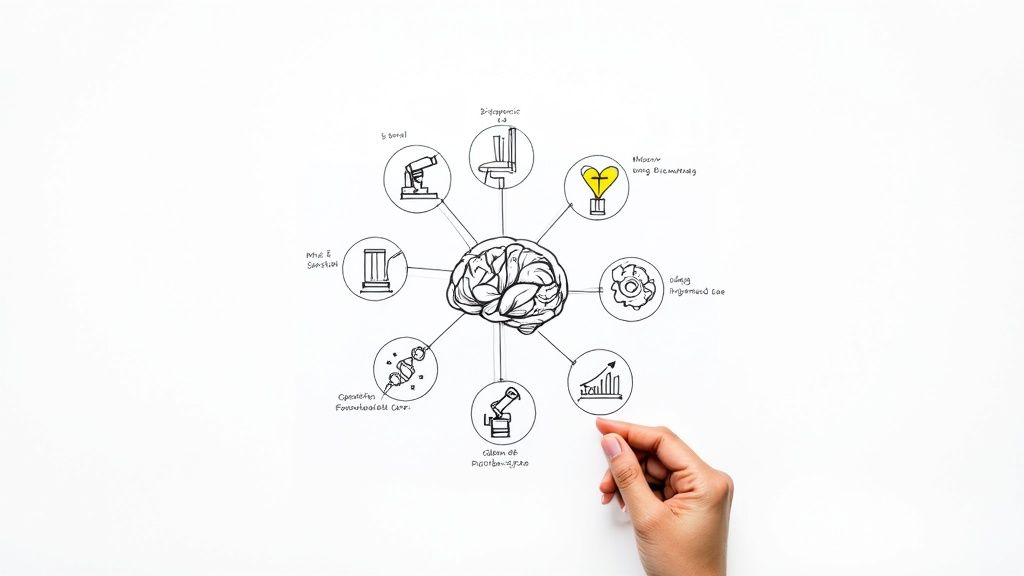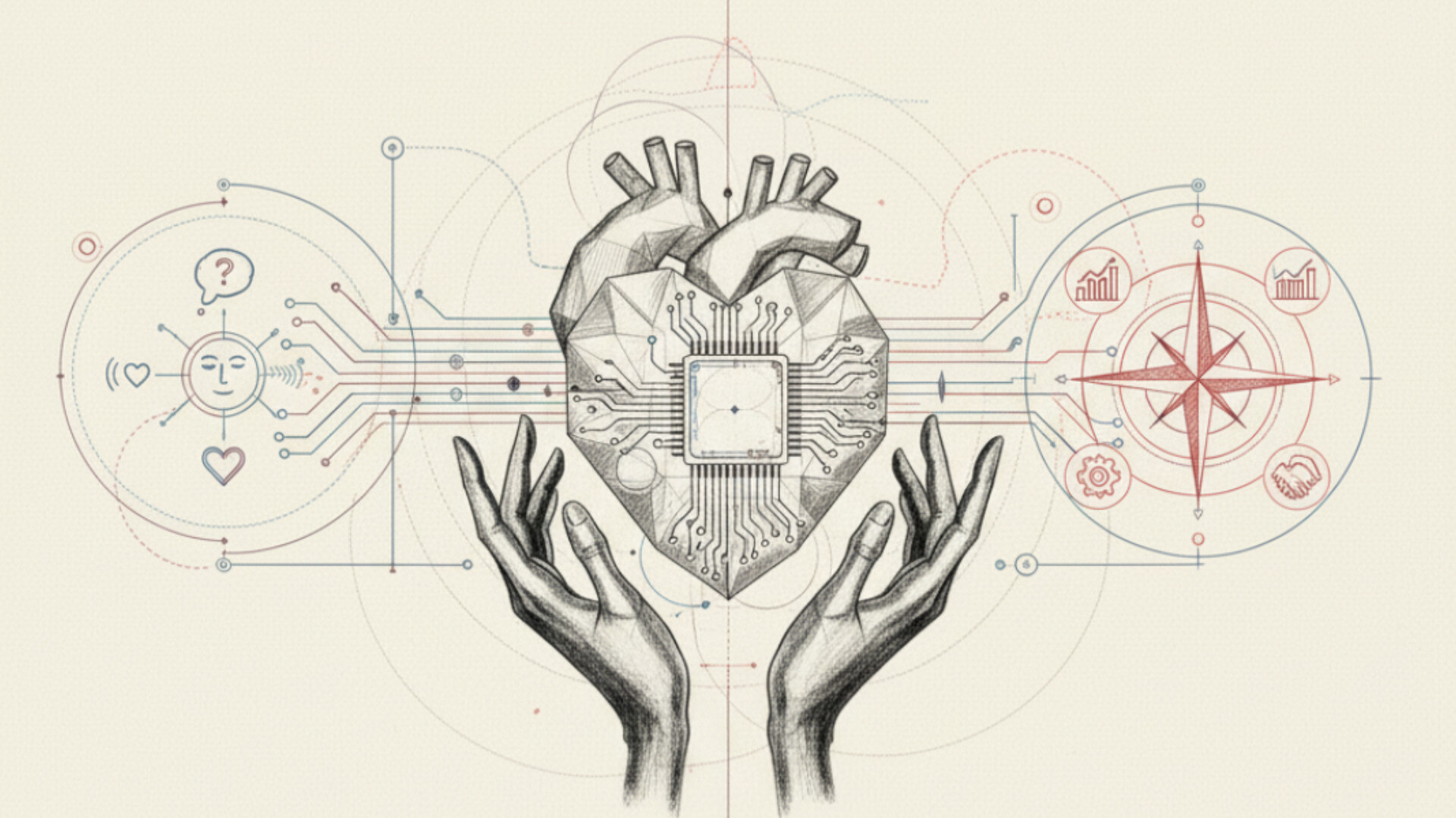A Guide to AI in MedTech and Healthcare
Explore the transformative impact of AI in MedTech. This guide covers key use cases, market trends, implementation challenges, and how to adopt AI solutions.
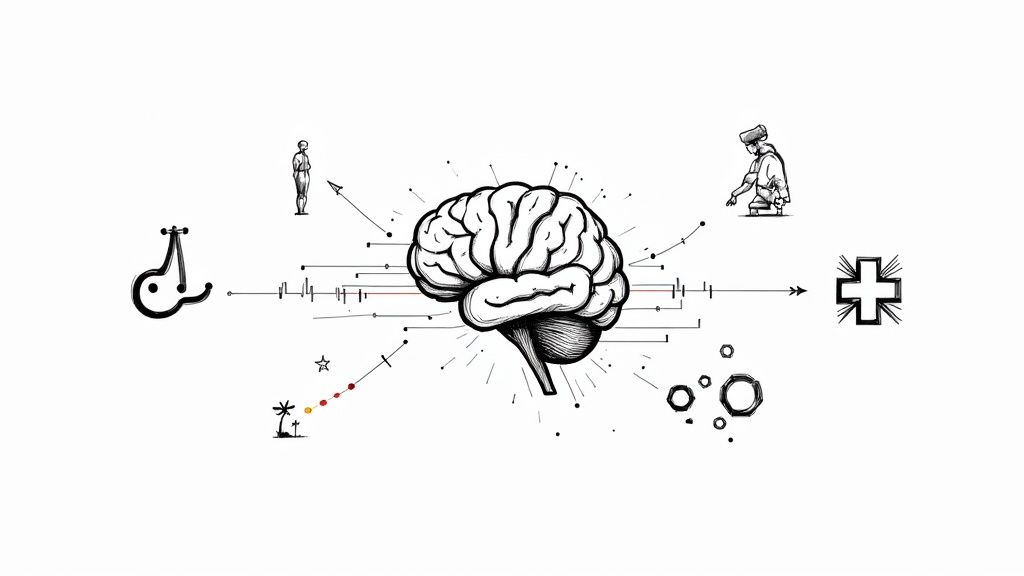
For years, we've talked about AI in healthcare as some far-off idea. That's over. Today, AI isn't just a concept; it’s a practical tool being used right now to solve real problems in medical technology, fundamentally changing how we deliver patient care. It’s quickly moving from a "nice-to-have" competitive edge to a core part of the operational toolkit for any clinic or hospital serious about better outcomes.
The New Frontier of Patient Care
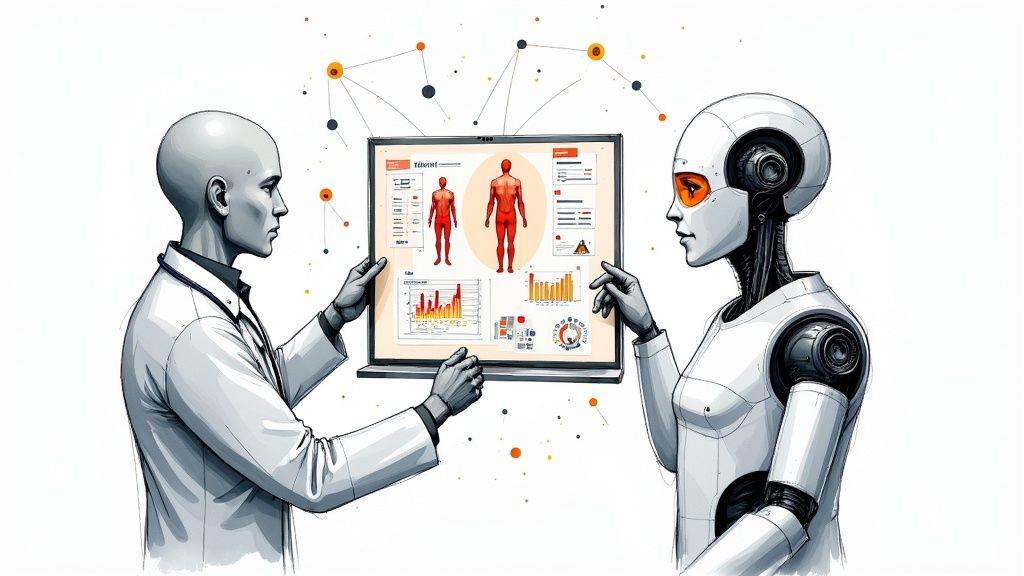
Bringing artificial intelligence into the MedTech world isn't just an upgrade—it's a complete shift in thinking. We're moving beyond simple devices to create systems that are intelligent, predictive, and incredibly personalized. This guide breaks down what that actually means, from the explosive market growth we're seeing to the specific, real-world use cases already making a difference.
MedTech companies are embedding AI to build tools that can sift through enormous, complex datasets—think medical images, genetic codes, and live patient vitals—at a speed and precision no human could ever match. This capability opens the door to catching diseases earlier, performing surgery with greater accuracy, and designing treatment plans built around a single person's biology. At its heart, this is about shifting healthcare from being reactive to proactive.
Why AI Adoption Is Accelerating
So, what's lighting the fire under this trend? A few things are coming together at once. For one, the explosion of healthcare data is simply too much for humans to handle alone; AI is the only way to make sense of it all. At the same time, the pressure for more affordable and efficient healthcare is pushing providers to innovate.
Sophisticated AI Solutions are stepping in to meet these demands head-on. They're helping by:
- Enhancing Diagnostic Accuracy: AI algorithms are brilliant at finding subtle anomalies in MRIs or CT scans that even a trained radiologist might overlook.
- Personalizing Treatment Plans: By cross-referencing a patient's genetic markers with their medical history, AI can help pinpoint therapies that offer the best results with the fewest side effects.
- Optimizing Hospital Operations: From smart scheduling to managing supply chains, workflow automation handles the administrative grind, which cuts costs and, more importantly, lets clinical staff focus on patients.
The core promise of AI in MedTech is not to replace clinicians but to augment their abilities. It's about creating a powerful collaboration between human expertise and machine intelligence to deliver a higher standard of care.
For any organization looking to get in on this, winging it won't work. You need a clear path forward. Building a solid plan, often with the help of AI strategy consulting, is the only way to make sure the tech you adopt actually solves a real clinical problem and meets your business goals. It all starts with understanding the landscape and finding the right place to make an impact.
A Look at the AI in MedTech Market Landscape
To really get a feel for how big this shift is, we have to follow the money. The numbers behind the AI in MedTech market tell a powerful story of explosive growth and serious investor confidence. It’s a field where data isn’t just improving patient care; it’s building incredible economic momentum.
Mapping this landscape means looking at all the pieces, including key segments like additive manufacturing within the medical market. The growth isn’t happening evenly across the board. Certain technologies and applications are magnets for investment, and knowing which ones helps any healthcare organization build an AI strategy that actually works.
Let’s talk numbers. The global AI in healthcare market recently clocked in at around USD 29.01 billion. That’s a massive validation right there. But the real story is where it's headed: forecasts show it rocketing to USD 504.17 billion by 2032.
That jump represents a compound annual growth rate (CAGR) of roughly 44.0%. It’s a clear signal of sustained, aggressive investment. Right now, North America is leading the charge, holding nearly 49.29% of the market share.
This table breaks down the key growth projections for the AI in healthcare market, showing just how fast this sector is expanding.
Projected Growth of the Global AI in Healthcare Market
| Metric | Value |
|---|---|
| Recent Market Valuation | USD 29.01 Billion |
| Projected Valuation by 2032 | USD 504.17 Billion |
| Compound Annual Growth Rate (CAGR) | 44.0% |
| North America's Market Share | 49.29% |
These figures don't just point to growth—they scream acceleration. The steep upward curve tells us that early adopters are proving AI's value, which in turn is pulling more investment and wider participation into the market.
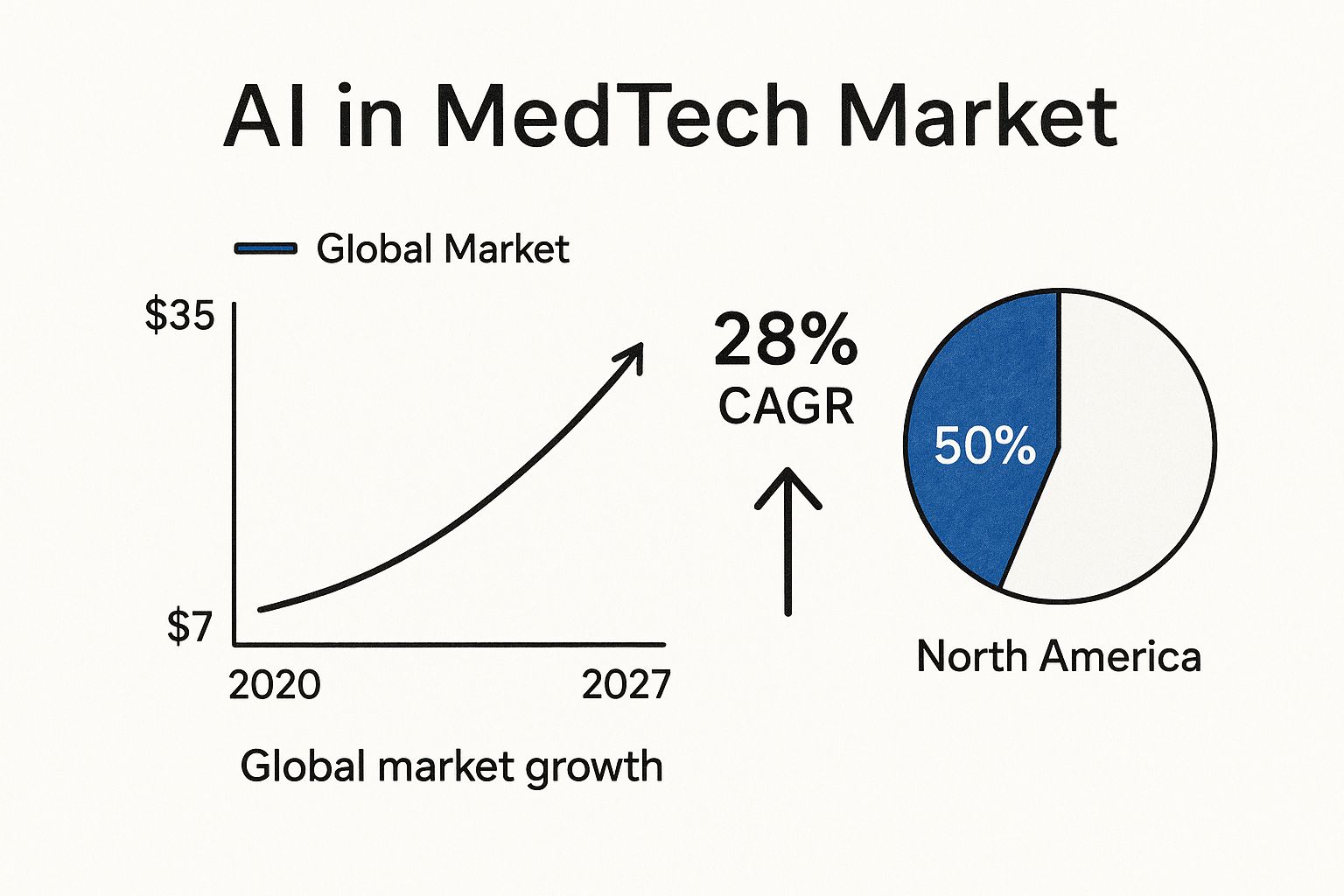
Regional Dynamics and Global Trends
North America's dominance is no accident. It’s fueled by a perfect storm of heavy venture capital funding, a high density of top-tier AI research hubs, and a regulatory climate that’s slowly but surely making room for new tech. This environment has become a hotbed for both nimble startups and established MedTech giants.
But the rest of the world isn't just sitting back and watching. Europe and the Asia-Pacific regions are also experiencing major growth spurts, often pushed forward by government-led initiatives to modernize healthcare. This global race is sparking incredible innovation across the board.
The key takeaway is that the AI in MedTech market is not just expanding—it's maturing. We're moving from a phase of speculative investment to one where tangible, revenue-generating applications are becoming the norm.
Getting a handle on these market dynamics is the first step toward building a winning adoption plan. For any organization in this space, figuring out where the growth is and why it’s happening is crucial. This insight should drive every strategic decision, from product roadmaps to market entry.
By exploring specific applications, like those found with AI within the healthcare industry, you can get a more focused view of the opportunities. This strategic alignment is what turns market potential into real-world impact and better outcomes for patients. The momentum is undeniable.
How AI Is Reshaping Medical Devices
Forget the abstract talk about market trends and investment figures for a moment. The real story of AI in medtech is happening at the bedside and in the operating room. AI isn't some add-on feature anymore; it’s being woven directly into the core of medical devices, making them smarter, more predictive, and incredibly precise. This is where theory becomes a life-saving reality.

The numbers themselves tell a compelling story. The global medical equipment market was recently valued at over USD 542 billion and is expected to climb to nearly USD 887 billion by 2032. The biggest drivers of this growth are the very areas where AI is making the deepest impact: diagnostic imaging (holding 20% of the market), surgical equipment (18%), and in-vitro diagnostics (10%). These aren't just statistics; they represent a fundamental shift in how we approach healthcare.
This massive expansion is fueled by foundational advancements in areas like healthcare software development, which builds the intelligent engines that power these modern devices.
A Second Set of Eyes for Diagnostic Imaging
Diagnostic imaging is probably the most clear-cut example of AI in action. Radiologists traditionally spend countless hours poring over scans, searching for tiny anomalies. Today, AI algorithms—trained on millions of past MRIs, CT scans, and X-rays—can analyze these images in a fraction of the time, flagging potential issues the human eye might overlook.
This isn't about replacing the expert. It’s about giving them a superpower.
- Prioritize urgent cases: The AI can instantly spot critical findings, like a brain bleed, and push that case to the top of the queue.
- Improve accuracy: By cross-referencing a scan with a massive dataset, algorithms can help reduce both false negatives and false positives.
- Speed up workflows: What once took hours can now take minutes, freeing up clinicians to focus on treatment and patient care.
This kind of data-driven insight is a core function of modern AI tools for business in the medical field, turning overwhelming amounts of information into clear, actionable intelligence.
Making Surgical and Wearable Devices Smarter
The operating room is also getting a major upgrade. AI-guided surgical robots give surgeons a level of stability and precision that is simply beyond human hands alone. These systems can analyze live data during an operation, helping to guide instruments, minimize tremors, and improve patient outcomes.
At the same time, AI is making everyday health monitoring proactive instead of reactive. It's making a huge difference in the capability of devices like advanced fall detection alarms, which can now offer far greater accuracy.
AI-powered wearables are shifting healthcare from a reactive to a predictive model. Instead of just treating sickness, we can now anticipate it, allowing for earlier and more effective interventions.
These smart sensors don't just track steps; they monitor vital signs around the clock. By using machine learning, they can identify subtle patterns that might signal an oncoming cardiac event or a dip in blood sugar, giving both patients and doctors a crucial heads-up.
The Path Forward with Intelligent Devices
Bringing an AI-powered device to life is no small feat. As we explored in our AI adoption guide, it all starts with a clear strategy—one grounded in real clinical needs and a solid plan for handling data and navigating regulations.
Turning that vision into reality requires a disciplined AI Product Development Workflow to ensure the final product is not only effective but also completely safe. This is why many organizations turn to experts for AI strategy consulting, getting help to map out the entire journey from initial concept to a successful rollout. With the right plan and the guidance of our expert team, AI-enhanced devices will continue to set new standards for what's possible in patient care.
AI-Powered Diagnostics and Clinical Support
Beyond just making existing devices smarter, AI's biggest splash in medtech is happening right where it matters most: in diagnostics and clinical decision-making. This is where AI stops being a background tool and becomes a genuine partner for clinicians, helping them reach diagnoses with a speed and accuracy we've never seen before.
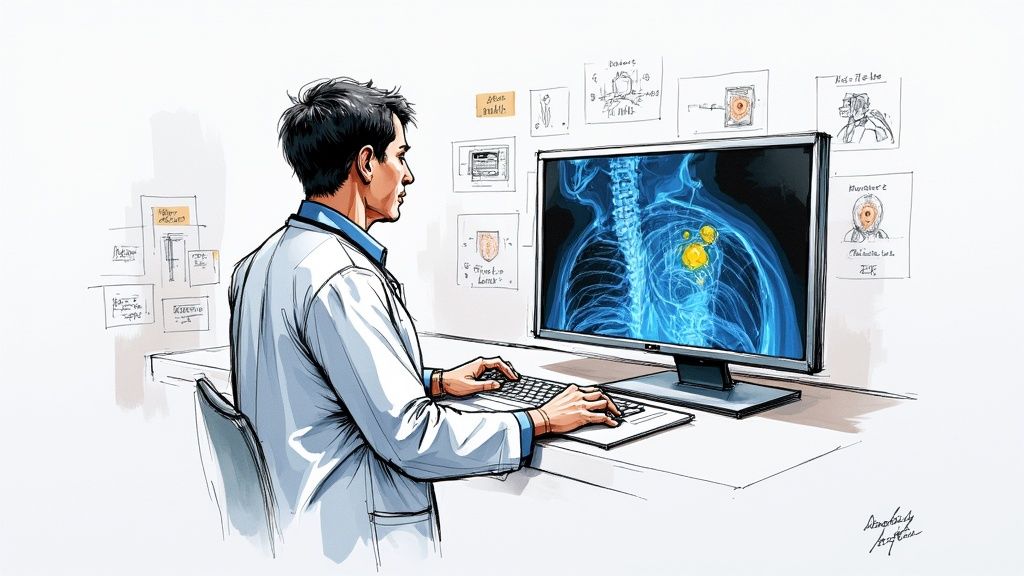
We’re no longer talking about hypotheticals. AI algorithms are proving themselves in the real world, often matching—and sometimes even outperforming—human analysis. Think of it as giving doctors a highly trained co-pilot who can spot subtle patterns in complex data that the human eye might miss. This partnership doesn't replace a clinician's expertise; it amplifies it, leading to faster, more confident decisions.
From Scans to Insights in Minutes
AI diagnostic tools are quickly becoming the engine inside modern medical devices, especially in detection and diagnosis, which are now the biggest drivers of market revenue. In medical imaging, for example, we've seen incredible tools like Qure.ai's qXR, an algorithm that flags early signs of lung cancer on chest X-rays. Another great example is RapidAI's platform, which can analyze a CT scan and alert a stroke team to a brain hemorrhage in minutes, not hours.
This isn't just happening in a lab. Regulatory bodies are taking notice and giving their stamp of approval. The FDA’s clearance of DermaSensor, an AI-powered device that helps primary care doctors spot signs of skin cancer, is a huge vote of confidence. It shows these technologies are passing the toughest tests for safety and effectiveness.
The real value here is simple: AI handles the repetitive, data-heavy work. This frees up clinicians to focus their skills on what truly requires their expertise—complex patient cases, thoughtful treatment planning, and ultimately, improving outcomes.
The Rise of Clinical Decision Support Systems
This diagnostic capability is now being built into much larger platforms called Clinical Decision Support Systems (CDSS). These systems function like an intelligent command center, giving clinicians evidence-based recommendations in real-time, all based on a specific patient's data.
A CDSS can be a game-changer by:
- Flagging Potential Drug Interactions: By cross-referencing a patient’s full medication list, the system can instantly warn of risky combinations.
- Suggesting Diagnostic Tests: It can analyze symptoms and medical history to recommend the most logical next steps for diagnosis.
- Providing Treatment Guidelines: The system can compare a patient's profile against the latest clinical research to suggest the best path forward.
This kind of intelligent backup is essential in today’s healthcare environment, where the goal is to get the best results as efficiently as possible. By offering data-backed guidance, a CDSS helps ensure every patient gets the same high standard of care. For example, tools like the Clinic AI Assistant are built to do just that—smooth out clinical workflows, cut down on paperwork, and let doctors spend more quality time with patients.
Building Your AI in MedTech Adoption Strategy
Knowing what AI can do in medtech is one thing. Actually making it work in the real world? That’s a whole different ballgame. A clear, practical strategy is the only way to move from a cool concept to real clinical impact. This isn't about chasing shiny new tech; it's about methodically finding real problems that AI is uniquely built to solve.
Think of your strategy as a roadmap. It’s what will guide you through the maze of data infrastructure, regulatory minefields, and getting your team on board. Without a solid plan, even the most exciting AI projects can fizzle out before they even get started. The first rule is always the same: start with the problem, not the algorithm.
Identifying the Right Problems for AI to Solve
Before you even think about building vs. buying or start looking at vendors, your team needs to zero in on specific, high-value challenges. Are you trying to cut down on diagnostic errors in radiology? Or maybe you just need to free up staff by automating the mountain of administrative paperwork?
Picking a concrete issue gives you a clear target and a way to measure success. Good places to start looking often involve:
- Repetitive, high-volume tasks: Think about a radiologist analyzing thousands of images or a clerk processing patient intake forms. These are perfect jobs for an AI.
- Data-intensive analysis: When clinicians are drowning in data from wearables or genomic sequencing, AI can be the tool that spots the crucial patterns hidden in the noise.
- Process bottlenecks: Find where your workflow gets jammed. Is it in clinical trial recruitment? Or maybe supply chain management?
Navigating the Build vs. Buy Decision
Once you have a problem in your sights, the next big question is whether to build a custom AI from scratch or buy a solution that’s already on the market. There's no single right answer—it all depends on your organization's specific needs and resources.
Building a Custom Solution This path gives you total control and a solution that fits your workflow like a glove. But be warned: it demands serious in-house talent, a long development timeline, and a hefty budget.
Buying an Off-the-Shelf Solution Grabbing a pre-built tool from a vendor gets you up and running much faster with lower initial costs. The trade-off is that you get less customization, and you’ll likely have to adjust your processes to fit the software, not the other way around.
The best route is often a mix of both. Many organizations dip their toes in the water with a proven third-party platform to score some early wins. As they get more comfortable and their needs evolve, they start building custom integrations or models on top of it.
Crafting a Comprehensive Implementation Plan
Getting AI adoption right is so much more than just flicking a switch on new software. You need a complete plan that addresses everything from data security to team training. A truly solid strategy will stand on a few key pillars.
- Data Infrastructure and Governance: First things first, you need access to high-quality, secure, and compliant data. This is the fuel that makes any AI model run.
- Regulatory Compliance: The rulebook for AI in medtech is complex and always changing. Your plan absolutely must include a clear strategy for getting approvals from bodies like the FDA or meeting standards like the EU AI Act.
- Change Management and Training: You can have the best tool in the world, but if your clinical staff doesn’t trust it or know how to use it, it’s worthless. Proper training and transparent communication are non-negotiable for getting people to actually use the new tech.
- Measuring Success: How will you know if it's working? You need to define your key performance indicators (KPIs) from day one. Whether it’s better diagnostic accuracy, lower operational costs, or faster patient throughput, you need hard numbers to prove the ROI.
Turning this plan into a working, validated product that clinicians can rely on every day is a journey in itself. Understanding the entire AI Product Development Workflow is critical. You can get a detailed breakdown of this entire journey, from strategy to a market-ready tool, in our guide to AI Implementation Support. By breaking down the process into these manageable steps, you can take the mystery out of AI implementation and build a real framework for success.
The Future of AI in Medical Technology
When we look ahead, the path for AI in medtech isn't just about gradual improvement; it's heading toward a future where AI is woven into the very fabric of healthcare. The next ten years will be marked by systems that don't just provide insights but act as autonomous, collaborative partners in R&D, clinical work, and patient care.
We're really just at the starting line. The true magic will come from the partnership between skilled human experts and these intelligent systems, and that combination is what will genuinely improve medicine for everyone.
Emerging Trends Defining the Next Decade
One of the most exciting areas to watch is how generative AI is shaking up drug discovery. Think about it: bringing a new drug to market has historically been a decade-long, multi-billion-dollar gamble. Now, AI can comb through massive biological datasets to pinpoint promising molecular compounds in a matter of months. This could completely collapse the R&D timeline for new treatments.
At the same time, we're shifting away from one-size-fits-all medicine toward what we call hyper-personalized treatment. By analyzing a patient's unique genetic code, their entire medical history, and even live data from their smartwatch, AI can suggest therapies designed specifically for their body. This is a massive leap toward truly individual care.
And let's not forget the operating room. It's on the brink of another huge change with the arrival of truly autonomous robotic surgery. The systems we have today are fantastic assistants, but the robots of tomorrow will be collaborators. They'll learn from every procedure they're a part of and eventually perform certain tasks with a level of precision beyond human hands—always under the watchful eye of a surgeon, of course.
Navigating Ethical and Regulatory Frontiers
All this incredible progress brings with it a heavy dose of responsibility. As these AI systems gain more autonomy, we have to tackle the tough ethical questions head-on.
Innovation without ethical oversight is a liability. The future of AI in medtech depends on building systems that are not only powerful but also fair, transparent, and trustworthy.
Here are a few of the biggest ethical hurdles we need to clear:
- Data Bias and Equity: If an AI is trained on data that mostly comes from one demographic, its recommendations could easily worsen health disparities for others. Making sure our training data is fair and representative is an absolute must.
- Algorithmic Transparency: When an AI suggests a diagnosis or treatment, doctors and patients have a right to understand why. Opaque, "black box" algorithms just won't cut it in a field where lives are on the line.
- The Future of Healthcare Jobs: AI is here to augment clinicians, not replace them. But it will absolutely change how they work. We need to focus on continuous training to help medical professionals adapt to new AI-powered tools and workflows.
The rulebooks are also trying to catch up. New regulations like the EU AI Act are creating a new baseline for high-risk AI, requiring strict proof of safety, transparency, and risk management. Being proactive about compliance and ethics isn't just a good idea anymore—it's essential for earning the trust of both patients and providers.
Ultimately, how well we integrate these powerful tools will always come down to the expertise and sound judgment of our expert team, making sure technology remains in service of humanity.
Wrapping Up: Your AI in MedTech Questions Answered
To finish up, let's tackle some of the most common questions we hear about bringing AI into the medical technology space. Think of this as a quick-reference guide to clear up confusion and help you move forward with confidence.
What’s the Toughest Hurdle in Bringing AI to MedTech?
In a word: data. Everything hinges on data. An AI model is a reflection of the information it learns from, and healthcare data is one of the most complicated types out there.
Finding enough high-quality, diverse, and accurately labeled data is a massive undertaking. On top of that, you have to protect patient privacy every step of the way, adhering to strict rules like HIPAA. Then there's the regulatory maze—getting FDA or CE mark approval requires meticulous validation and a deep understanding of the rules. A smart data plan, often built with the help of expert AI strategy consulting, is the only real way to start.
How Can a Smaller MedTech Company Realistically Start Using AI?
Don't try to boil the ocean. For smaller companies, the key is to start with a single, high-value problem that AI is perfectly suited to solve.
Maybe it's automating a tedious part of a diagnostic screening process. Or perhaps it's simplifying an internal administrative task with a bit of internal tooling. You absolutely do not need to hire a huge team of data scientists from day one.
Using powerful, ready-made AI tools for business or working with a partner for AI Automation as a Service gets you access to incredible technology without the crippling upfront cost. This lets you show a real return on your investment quickly, building a solid case for expanding your efforts down the road.
The best way for a smaller company to get into AI is to launch a focused pilot project. As we covered in our AI adoption guide, proving AI’s value in one specific area creates the momentum you need for a wider rollout.
Is the Goal of AI to Replace Doctors?
Not at all. The real purpose of AI in medicine is to augment human skill, not make it obsolete. AI is brilliant at sifting through mountains of data and spotting patterns a person might miss, and it does it in seconds.
This frees up doctors, nurses, and lab technicians from the monotonous, data-heavy work that bogs them down. It lets them concentrate on what humans do best: applying critical thinking, showing empathy to patients, and making nuanced decisions based on experience and instinct.
Think of AI as the ultimate clinical assistant. It enhances a doctor's ability to diagnose and treat, which means better care and better outcomes for patients. It’s all about creating a powerful partnership between human expertise and machine intelligence, and our expert team can help you strike that perfect balance.
Ready to see what intelligent automation and sharp, strategic insights can do for your MedTech operations? At Ekipa AI, we specialize in turning promising concepts into real-world impact. Let's explore how our custom AI strategies can drive your innovation and elevate patient care.


